CBE major and Iowa Space Grant Consortium fellow researches creation of fuel for Mars missions
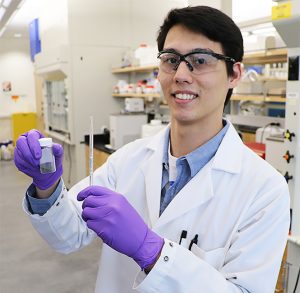
Like many other middle school students, Brandon Vance went on a class trip to Washington, D.C. Now, as an undergraduate university researcher, he will be headed back to the nation’s capital with a spot in the prestigious Posters on The Hill event with his name on it.
Each spring the Council on Undergraduate Research (a nationwide membership group that assists collegiate administrators, researchers, staff and students in support of undergraduate research) hosts this special poster session that allows undergraduate college students from around the nation to show off their research projects to members of Congress and their staffers. Many apply. Few are selected. Vance is among 60 students who will display, from more than 350 who filed the paperwork for this year’s event, which will take place April 28-30.
Vance is a senior in the Department of Chemical and Biological Engineering (CBE). His research project, “Designing Catalysts for the Direct Production of Methane Fuel on Mars,” is supported by a fellowship through the Iowa Space Grant Consortium, a NASA funded agency affiliated with the Department of Aerospace Engineering at Iowa State. His mentor is CBE associate professor Jean-Philippe Tessonnier and he’s an undergraduate member of Tessonnier’s research group. Vance is also a McNair Scholar at Iowa State, studying with assistance from the program that aids first generation, underrepresented, minority and low-income students in preparing for graduate school an attainment of a Ph.D.
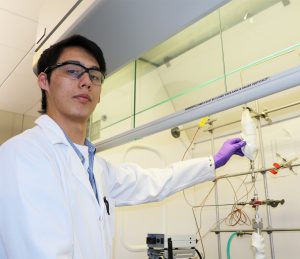
Vance joined Tessonnier’s group in the fall of 2017 and began working on this project in the summer of 2018 with the Center for Biorenewable Chemicals (CBiRC) Research Experience for Undergraduates here at Iowa State. “I then applied for the Iowa Space Grant Consortium fellowship so I could keep working on the project,” Vance said.
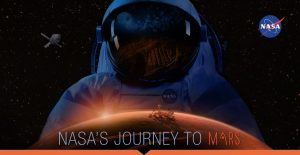
NASA plans to one day send manned missions to Mars. Getting crews and equipment to and from what will be the furthest destination that has ever been reached is no easy task. All sorts of challenges must be addressed. Vance’s research looks at the problem of how to fuel space craft for the return to Earth from Mars. “You can get a rocket to Mars, but it’s impossible to send enough fuel with them to get them back, Vance explained. “So it’s necessary to create the fuel to get back right there on the surface of Mars.”
Vance’s project examines how to turn carbon dioxide and hydrogen gas into methane for that fuel. It’s known as carbon dioxide methanation, and is done through a catalyzed process (one which enables a chemical reaction to proceed at a faster rate or under different conditions than would normally be possible). It’s a procedure used in industry to create synthetic, or substitute, natural gas. But the catalysts currently used can’t stand the high operating temperatures that would occur with this particular process that would take place on Mars. Vance’s project addresses coming up with a catalyst to overcome this, using a computational model he designed himself, along with dong the vast majority of the experimental work.
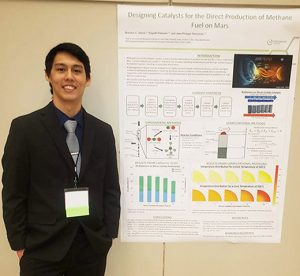
The process involves using a reactor. But whereas most people picture a reactor as being a huge piece of equipment, the reactor Vance uses in this project is less than a foot in length. It was built by a former chemical engineering graduate student, Elspeth Petersen, who was part of Tessonnier’s research group and also focused on developing catalysis to produce methane for rocket fuel, in research that was also supported by the Iowa Space Grant Consortium.
The biggest obstacle to overcome was the computational model. He reported it took more than three months to develop a model that gave physically meaningful results and provided true insight into the catalytic system being studied. He has worked to develop models that demonstrate the effects of the detrimental heat transfer with the performance of the catalyst.
The Washington, D.C. event will top a list of opportunities that Vance has had to show his research in recent months, including an oral presentation at the McNair Heartland Research Conference in Kansas City, the 2018 Annual American Institute of Chemical Engineers (AIChE) Student Conference in Pittsburgh, and the recent 2019 Iowa Space Grant Consortium Student Research Symposium at Drake University. He will also present his poster at the annual Research in the Capitol event April 1 at the Iowa Capitol.
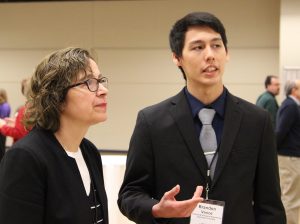
Vance plans to attend graduate school and plans to conduct research in biorenewables. He said he is honored to be in the spotlight with this research, but is quick to credit many mentors who have helped him achieve it – chief among them Tessonnier. “A very important part of my research is JP’s role in all this,” said Vance. “He’s letting me soak up the limelight, but he’s played a big part. Also my graduate student mentors Radhika Rao (now a postdoctoral researcher at the National Renewable Energy Laboratory) and Elspeth Petersen (who is now a scientist working at the NASA Kennedy Space Station in Cape Canaveral, Florida), who designed the reactor for the project and went a long way in helping me understand the lab work and the world of research. People say I am doing great things, but it is all a function of the mentorship other people have given me.”
Said Tessonnier: “Brandon is an outstanding student who quickly became a real asset to our group and our NASA-sponsored project. He demonstrated how the thermal conductivity of the catalyst support impacts the selectivity of the CO2 methanation reaction, which is relevant to the production of fuel for manned Mars missions. I am glad that Brandon was selected for the Poster on the Hill conference. He will proudly represent our department and Iowa State.”